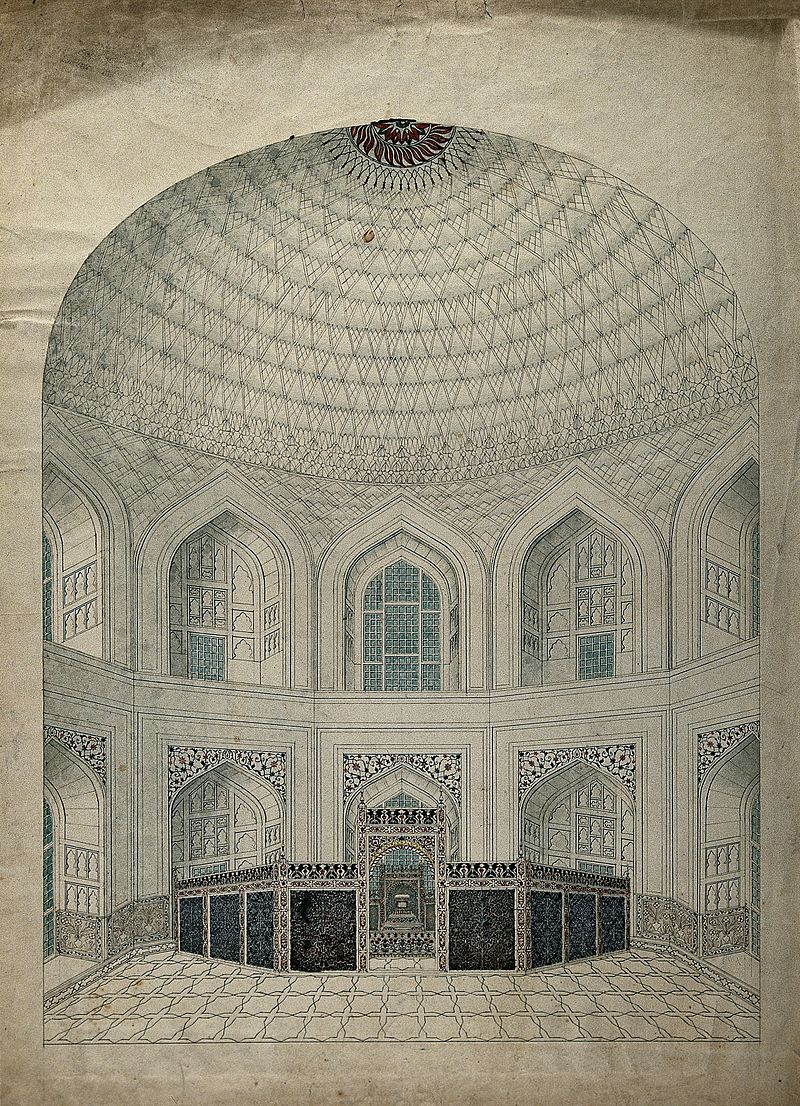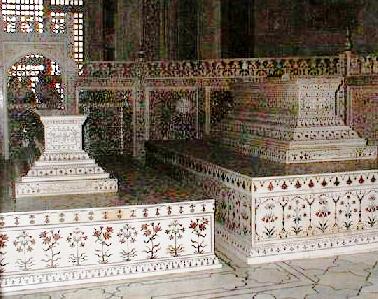The Taj Mahal; Arabic for "Crown of Palaces", named as an ivory-white marble mausoleum at india on the south bank of the "Yamuna" river in the city of Agra near the delhi. It was instruct in 1632 by the Mughal emperor, Shah Jahan (reigned 1628–1658), to house the tomb of his the favorite wife, Mumtaz Mahal. The tomb is the centrepiece of a 42-acre of complex, which carry a mosque and a guest house, and is set in formal gardens belted on 3 sides by a crenellated wall.


Interior view of the vaulted dome The false sarcophagi of Mumtaz Mahal and Shah Jahan over the tombs of Shah Jahan in the main chamber
and Mumtaz.
Construction of the mausoleum was essentially enup in the year 1643 but work continued on other phases of the project for another ten years. The Taj Mahal complex is accepted to have been endup in its entirety in the year of 1653 at a cost estimated at that time to be around "32 million" rupees, which in 2015 would be approximately estimated "52.8 billion" rupees (US $827 million). The development project workers employed some above 20,000 artisans under the guidance of a board of designer led by the court architect to the emperor, Ustad Ahmad Lahauri.
Architecture and design:
The Taj Mahal absorb and expands on the design culture of Persian and earlier Mughal architecture. Specific motivation came from the successful Timurid and Mughal constructions addind; the Gur-e Amir (the tomb of Timur, progenitor of the Mughal dynasty, in Samarkand), Humayun's burial, Itmad-Ud-Daulah's burial (sometimes called the Baby Taj), and Shah Jahan's own Jama Masjid in Delhi. While earlier Mughal buildings are primarilyhas constructed of purely red sandstone, Shah Jahan promoted the use of the white marble inlaid with the semi-precious stones. Buildings are under his patronage was reached new levels of refinement.
Shah Jahan and Mumtaz Mahal
Shah Jahan
"Shah jahan on a globe" from the Smithsonian Institution
Mumtaz Mahal
Artistic depiction of Mumtaz Mahal
Tomb
The burial(tomb) is the central focus and famoused of the entire complex attractive of the Taj Mahal. It is a large and bigg, white and white marble structure standing on a square podium and having of a equal building construction with an iwan (an arch-shaped doorway) topped by a large dome and at last finial. Like most Mughal burial, the basic elements are Persian in origin.
The base structure is a large multi-gaping cube with chamfered corners forming an unsymentrical eight-sided structure that is approximately 55 metres (180 ft) on each of the four long sides. Each side of the iwan is framed with a huge pishtaq or vaulted entrance with two equally shaped arched balconies stacked on either side. This motif of deformed pishtaqs is replicated on the chamfered of corner areas, making the design completely equal on all sides of the building. 4 minarets frame the tomb(burial), one at each corner of the plinth facing the chamfered corners. The main chamber houses the false sarcophagi of Mumtaz Mahal and Shah Jahan; the actual graves are at a lower level.


Interior view of the vaulted dome The false sarcophagi of Mumtaz Mahal and Shah Jahan over the tombs of Shah Jahan in the main chamber
and Mumtaz.
Construction of the mausoleum was essentially enup in the year 1643 but work continued on other phases of the project for another ten years. The Taj Mahal complex is accepted to have been endup in its entirety in the year of 1653 at a cost estimated at that time to be around "32 million" rupees, which in 2015 would be approximately estimated "52.8 billion" rupees (US $827 million). The development project workers employed some above 20,000 artisans under the guidance of a board of designer led by the court architect to the emperor, Ustad Ahmad Lahauri.
Architecture and design:
The Taj Mahal absorb and expands on the design culture of Persian and earlier Mughal architecture. Specific motivation came from the successful Timurid and Mughal constructions addind; the Gur-e Amir (the tomb of Timur, progenitor of the Mughal dynasty, in Samarkand), Humayun's burial, Itmad-Ud-Daulah's burial (sometimes called the Baby Taj), and Shah Jahan's own Jama Masjid in Delhi. While earlier Mughal buildings are primarilyhas constructed of purely red sandstone, Shah Jahan promoted the use of the white marble inlaid with the semi-precious stones. Buildings are under his patronage was reached new levels of refinement.
Shah Jahan and Mumtaz Mahal
Shah Jahan
"Shah jahan on a globe" from the Smithsonian Institution
Mumtaz Mahal
Artistic depiction of Mumtaz Mahal
Tomb
The burial(tomb) is the central focus and famoused of the entire complex attractive of the Taj Mahal. It is a large and bigg, white and white marble structure standing on a square podium and having of a equal building construction with an iwan (an arch-shaped doorway) topped by a large dome and at last finial. Like most Mughal burial, the basic elements are Persian in origin.
The base structure is a large multi-gaping cube with chamfered corners forming an unsymentrical eight-sided structure that is approximately 55 metres (180 ft) on each of the four long sides. Each side of the iwan is framed with a huge pishtaq or vaulted entrance with two equally shaped arched balconies stacked on either side. This motif of deformed pishtaqs is replicated on the chamfered of corner areas, making the design completely equal on all sides of the building. 4 minarets frame the tomb(burial), one at each corner of the plinth facing the chamfered corners. The main chamber houses the false sarcophagi of Mumtaz Mahal and Shah Jahan; the actual graves are at a lower level.



0 comments:
Post a Comment